Lugares imprescindibles en Eslovenia
La lista definitiva de lugares turísticos en Eslovenia: parques nacionales, región vinícola, costa adriática y más. Descubre los mejores lugares para visitar por región.
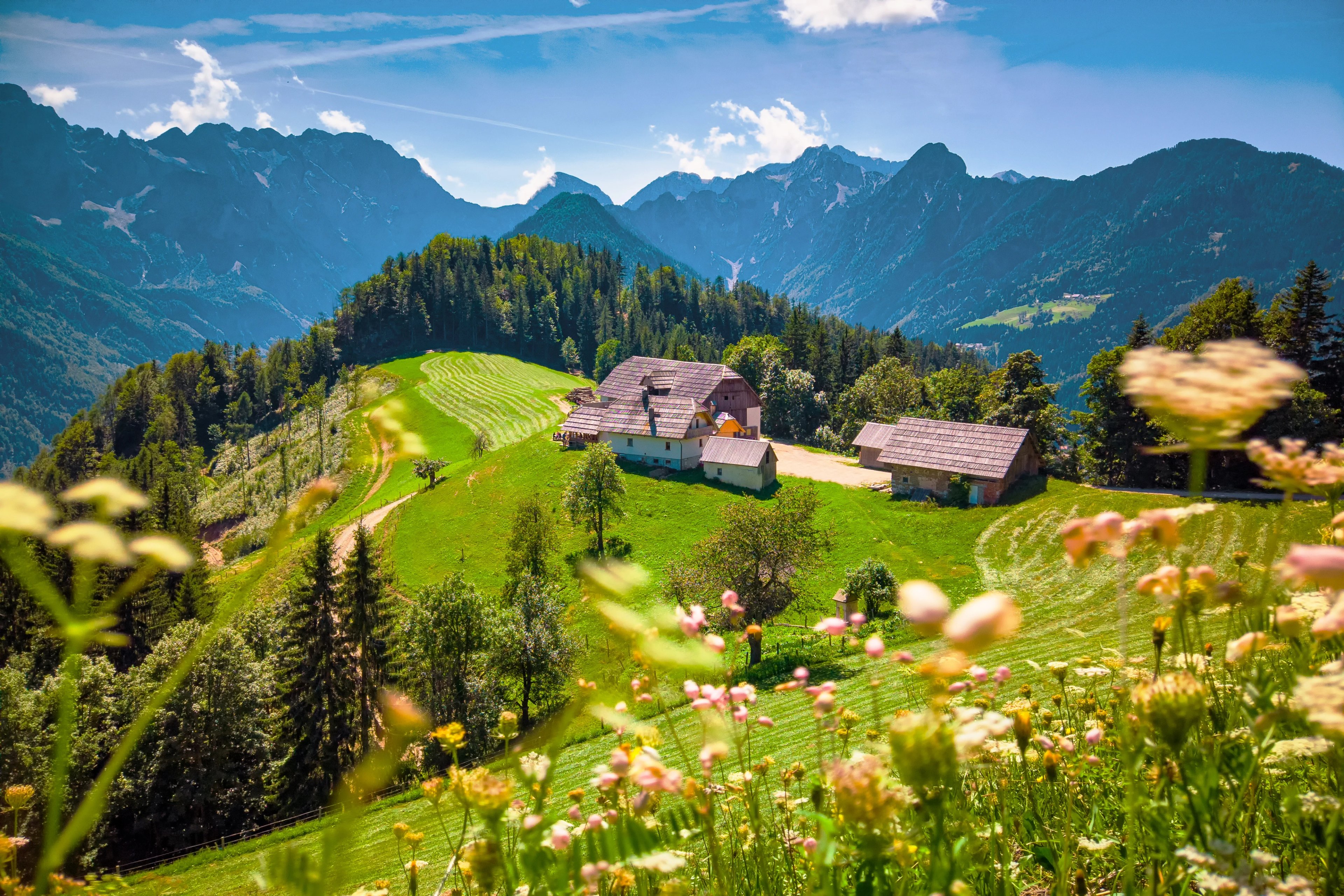
Eslovenia puede ser pequeña, pero ofrece una de las mezclas de paisajes y patrimonio cultural más diversas de Europa.
En un solo país, encontrarás picos alpinos que alcanzan casi 3000 m, ríos esmeralda, bosques primigenios, ruinas romanas, pueblos venecianos y cuevas que se extienden por kilómetros bajo tierra.

Hemos preparado una lista de lugares que ver en Eslovenia, dividida por regiones. Entonces, ¿qué debería incluir?
Alpes Alpinos y Julianos de Eslovenia
En el norte, Eslovenia revela su dramático lado alpino. Picos imponentes cerca de 3,000 m, lagos cristalinos y valles profundos definen esta región, donde los Alpes Julianos y el Parque Nacional Triglav crean un paisaje de contrastes sorprendentes.
Aquí los ciclistas encuentran pases de montaña legendarios, ríos esmeralda y clásicos pueblos alpinos, un telón de fondo inolvidable para paseos a través de algunos de los paisajes más impresionantes de Europa.
¿Quieres experimentarlo de primera mano? Nuestro Tour de los Alpes al Adriático, El Paseo de los Campeones de Eslovenia y Vacaciones de Ciclismo en Carretera por los Alpes Julianos muestran lo mejor de esta espectacular región montañosa.
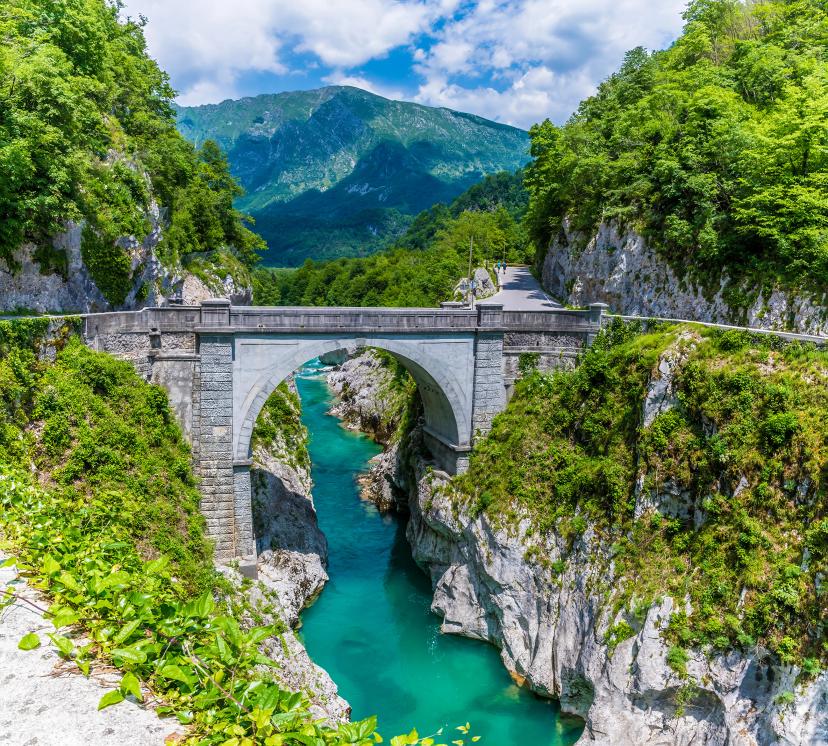
Napoleon’s Bridge
Built in 1750 and named after Napoleon’s troops who crossed it in 1797, this single-arch stone bridge spans about 55 m, rising 22 m above the emerald Soča River. Rebuilt after World War I battles along the Isonzo Front, it remains a striking historic crossing with panoramic views of the Julian Alps.

Lake Bled
Lake Bled is Slovenia’s most famous sight and for good reason. The lake was formed by glacial activity, and in its center sits the only natural island in Slovenia. A church has stood on that island since the 9th century, and today visitors still ring its “wishing bell.” Getting to the island is done the traditional way—by pletna, a wooden boat rowed standing up, a method unique to this area.
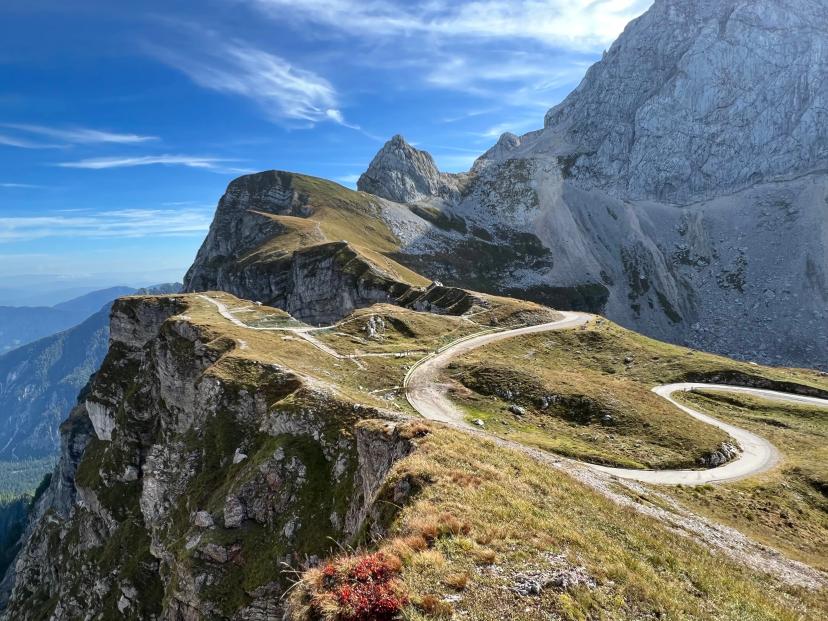
Mangart Saddle
Mangart Saddle, at 2,055 meters, is the highest road in Slovenia. The panoramic road leading up includes tunnels and dramatic switchbacks, ending just below Mount Mangart, Slovenia’s third-highest peak. It is a starting point for hikes, but even without climbing further, the views stretch across Slovenia and into neighboring Italy and Austria.
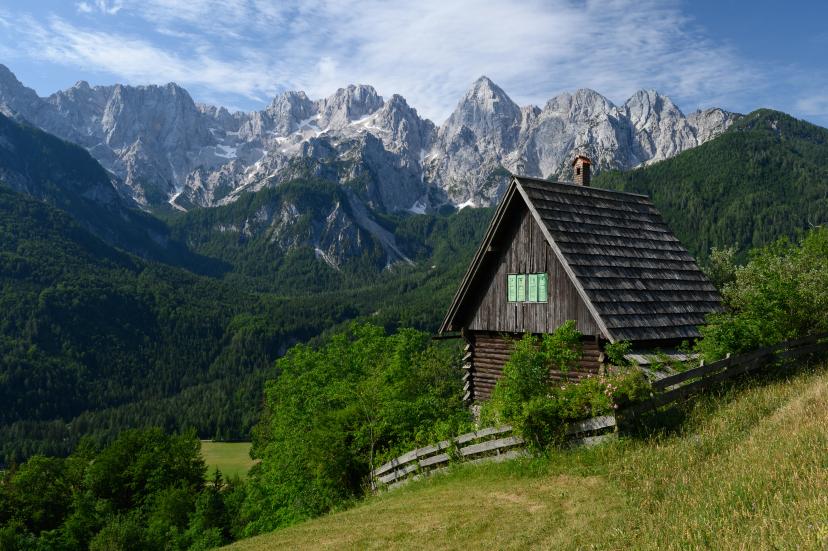
Julian Alps
Crossing north-west Slovenia and into Italy, the Julian Alps rise above 2,700 m and hold icons like the cobbled Vršič Pass with its 24 switchbacks. Glacial lakes Bled and Bohinj, turquoise rivers, and traditional alpine villages create dramatic scenery, while historic WWI routes add intrigue. Cyclists come for challenging ascents, sweeping panoramas, and some of Europe’s most rewarding mountain rides.
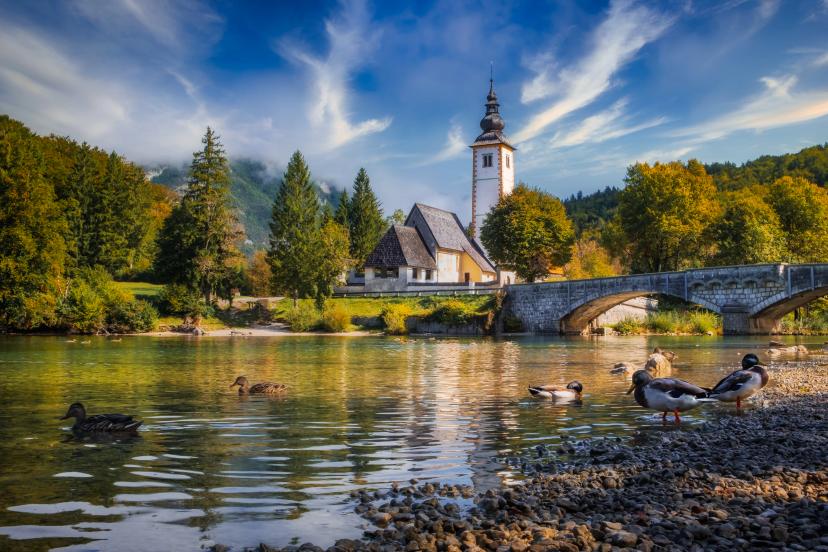
Lake Bohinj
Lake Bohinj is the largest permanent lake in Slovenia, 4.2 kilometers long and 1 kilometer wide, located inside Triglav National Park. It holds about 100 million cubic meters of water, fed by mountain streams and glaciers. Activities such as swimming, kayaking, and hiking around the lake are popular, but it remains much less developed than nearby Bled. A cable car leads from the lake up to Mount Vogel, where ski slopes in winter turn into hiking trails in summer.
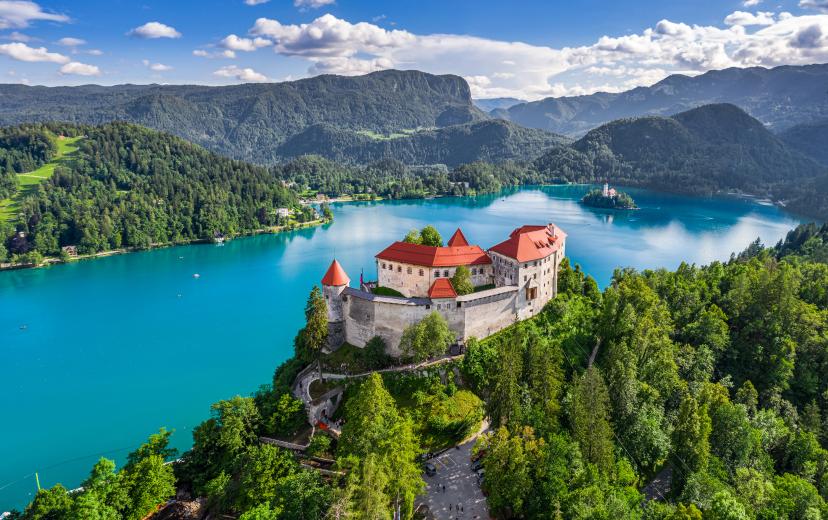
Bled Castle
Perched on a cliff 130 m above the emerald waters of Lake Bled, this is Slovenia’s oldest castle, first mentioned in 1011. Its Romanesque walls, medieval courtyards, and Renaissance towers overlook one of Europe’s most photographed lakes, with panoramic views of the Julian Alps and the tiny island church below. Inside, a small museum traces a thousand years of history, while a wine cellar, chapel, and printing workshop bring the past to life.

Zajamniki Alpine Pasture
High above Lake Bohinj on the Pokljuka Plateau, Zajamniki is one of Slovenia’s most picturesque alpine pastures. A ribbon of traditional wooden herdsmen’s huts stretches across a grassy ridge at about 1,300 m, with sweeping views of the Julian Alps and Mount Triglav. In summer, meadows burst with wildflowers and cows graze as they have for centuries, offering a glimpse of authentic mountain life. Reached by quiet forest roads, Zajamniki is a peaceful stop for adventurers seeking classic Alpine scenery.
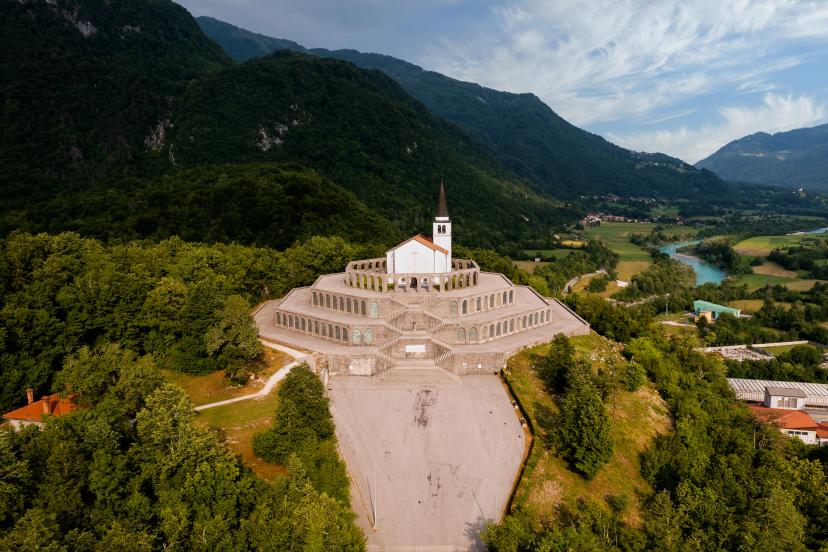
Kobarid Charnel House
The Italian Charnel House in Kobarid is a military ossuary built in 1938 to hold the remains of 7,014 Italian soldiers who died during World War I in the Isonzo Front battles. The circular structure is built around the pre-existing church of St. Anthony, and its inauguration was attended by Mussolini. It stands above the town of Kobarid and is part of the “Walk of Peace” heritage trail, which connects key sites from the front lines of the Great War across the Soča Valley.
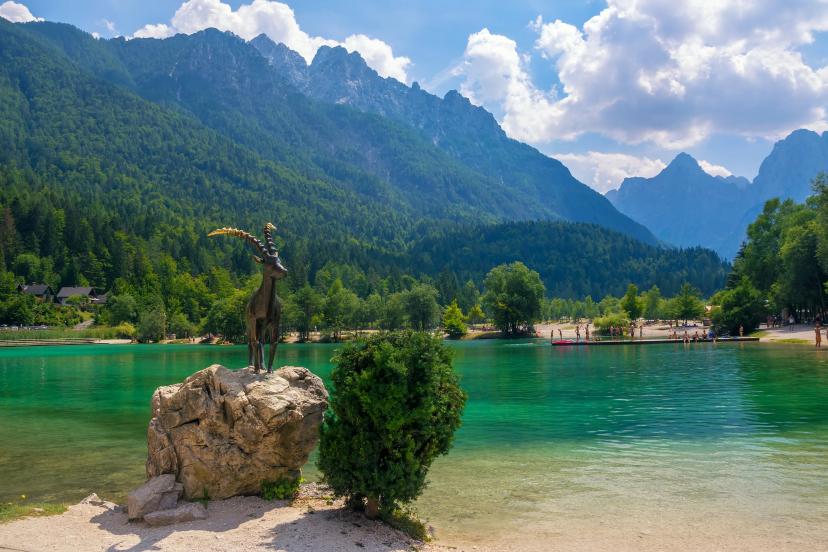
Lake Jasna
Lake Jasna consists of two connected artificial lakes near Kranjska Gora. Built for tourism, they are surrounded by walking paths and overlooked by the peaks of the Julian Alps. A wooden viewing tower, a bronze statue of an ibex, and clear alpine water make it one of the most photographed spots in the region.

Dovžanova Soteska
Located near Tržič in northern Slovenia, Dovžanova Soteska is a narrow limestone gorge carved by the Tržič Bistrica River. It is a protected natural monument and internationally known geological site, showcasing 300-million-year-old fossils and rare rock formations from the Paleozoic era. A scenic trail with bridges and interpretive panels follows the river through steep cliffs and natural rock arches, offering visitors both striking alpine views and a glimpse into deep geological history.
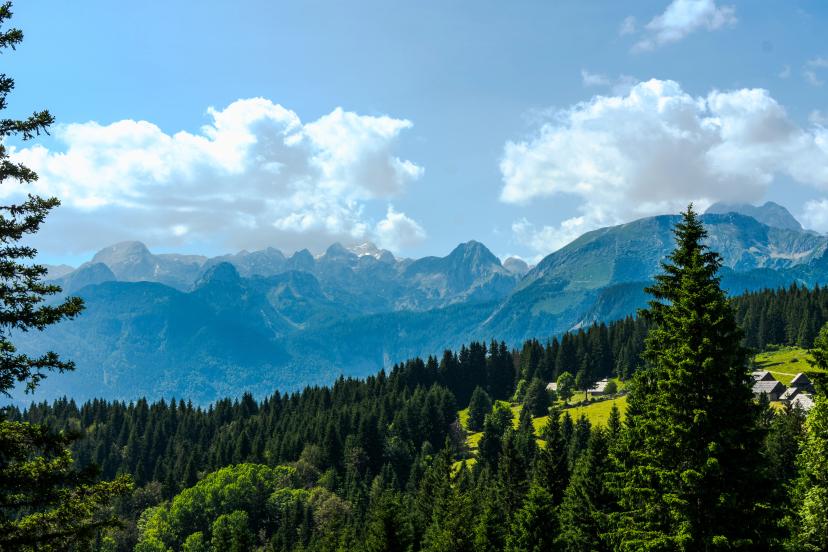
Pokljuka Plateau
Rising 1,200–1,500 m within Triglav National Park, Pokljuka is Slovenia’s largest high plateau and a showcase of pristine alpine nature. Vast spruce forests, peat bogs, and open pastures dotted with traditional shepherd huts create a landscape of striking beauty and rich wildlife, with sweeping views of the Julian Alps and Mount Triglav.
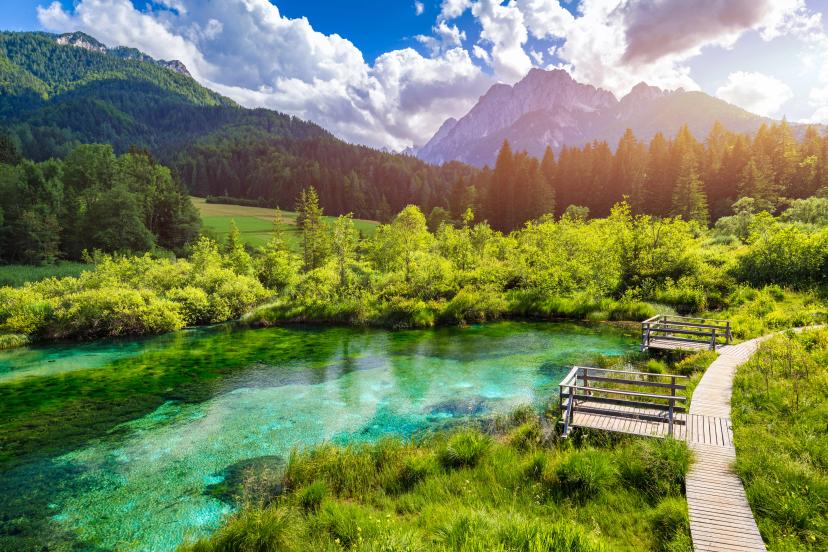
Zelenci Nature Reserve
Zelenci is where the Sava Dolinka River begins. The water rises through porous chalk and sand, creating bright emerald pools that never freeze, even in winter. The reserve covers 15 hectares and is home to rare species of plants and animals, including orchids and kingfishers. A wooden boardwalk and viewing tower make the area accessible for visitors, offering views of the surrounding Julian Alps. The constant temperature of the spring water is about 6°C year-round.

Castle Kamen
Above Begunje na Gorenjskem stand the ruins of this 12th-century fortress, once guarding a key trade route through the Draga Valley. Built by the Counts of Ortenburg and later the Lambergs, it was damaged by the 1511 earthquake and uprisings, leaving striking stone walls and towers that now offer panoramic views of the Karawanks and Sava plain.

Soča Valley
The Soča Valley is famous for the emerald color of the Soča River, which flows through deep gorges and past waterfalls. The area is popular for outdoor sports like rafting, kayaking, and hiking, and features an abundance of natural highlights, among others: the Great Soča & Tolmin Gorges, and stunning waterfalls like Virje, Kozjak and Slovenia’s highest - Boka. It is also a site of major World War I battles, remembered through a variety of museums and the Walk of Peace trail.
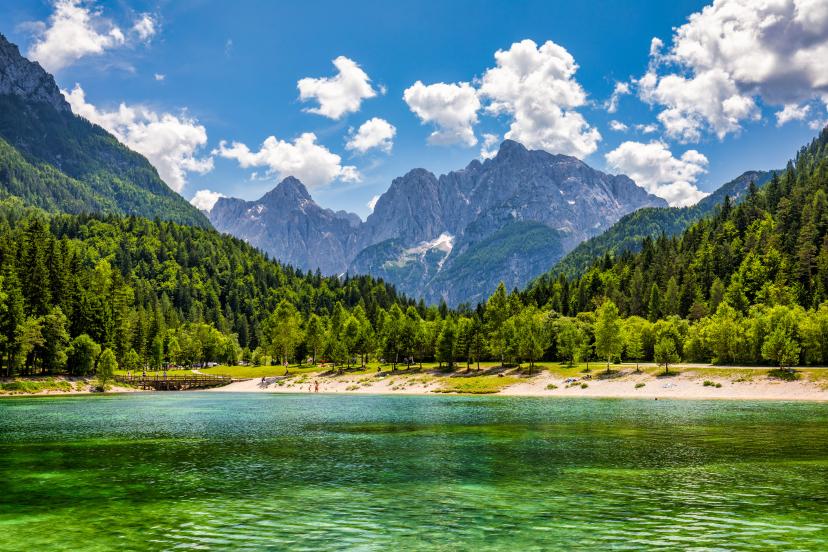
Triglav National Park
Slovenia’s only national park spans 880 km² of the Julian Alps and protects Mount Triglav, the nation’s 2,864 m peak and national symbol. A UNESCO Biosphere Reserve, it’s a landscape of glacial valleys, alpine lakes, and the emerald sources of the Soča and Sava rivers. Quiet roads and scenic climbs lead through Bohinj and the Soča Valley, offering cyclists pristine nature and classic Alpine views.

Matajur
Rising 1,641 m on the border of Slovenia and Italy, Mount Matajur offers sweeping views across the Soča Valley, the Julian Alps, and all the way to the Adriatic Sea on clear days. Its grassy slopes and open summit have long served as alpine pastures, while World War I left historic trails and memorials from the Isonzo Front. Today it’s a beloved cycling and panoramic viewpoint, combining gentle lower roads with a challenging final climb and a unique vantage point over two countries.

Robanov kot
A 5 km glacial valley in the Kamnik–Savinja Alps, Robanov Kot is protected as a Landscape Park and part of Natura 2000. Ringed by peaks like Ojstrica and Krofička, its floor of meadows and forests has been farmed since the 15th century by the historic Roban homestead. Quieter than nearby Logar Valley, it offers pristine alpine scenery, traditional mountain farms, and a peaceful escape into Slovenia’s highlands.
Karst y Eslovenia Mediterránea
En el suroeste, las vacaciones en bicicleta en Eslovenia adquieren un sabor mediterráneo. La meseta del Karst es famosa por sus cuevas, ríos subterráneos y viñedos de vino tinto, mientras que la costa adriática refleja siglos de influencia veneciana. Añade el clima soleado, las colinas en terrazas y las ciudades históricas, y esta región muestra un lado completamente diferente de Eslovenia. Descubre la región durante nuestro tour en bicicleta de los Alpes al Adriático.
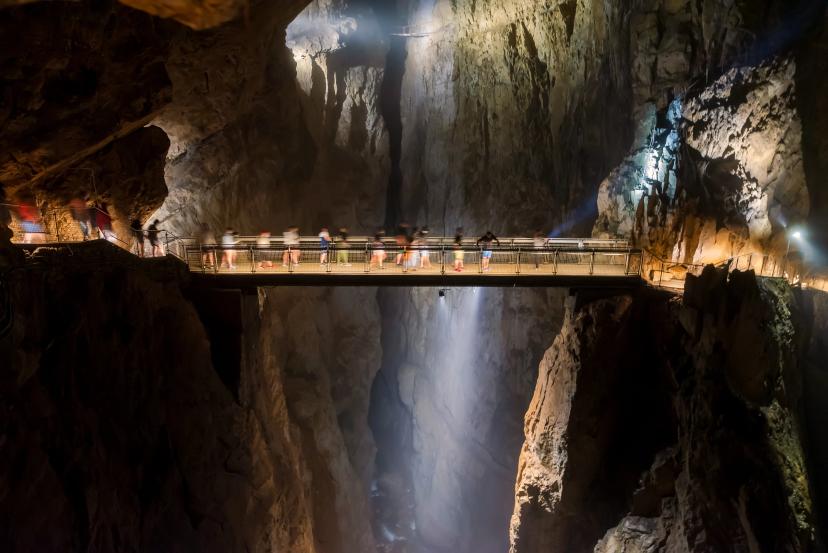
Karst Region
The Karst plateau gave its name to karst landscapes worldwide, known for caves, underground rivers, and sinkholes. This limestone region of southwestern Slovenia is home to the UNESCO-listed Škocjan Caves and countless smaller caves. Alongside the geology, visitors find stone-built villages, vineyards producing the strong red wine Teran, and traditions tied to this unique landscape.

Predjama Castle
Predjama Castle holds a Guinness World Record as the largest cave castle in the world. Built more than 800 years ago, it is integrated directly into a 123-meter cliff face. The castle became legendary thanks to the knight Erazem Lueger, who resisted a siege for over a year by using hidden passages that led out of the cave system below. Archaeologists have discovered a vast network of tunnels beneath the castle, more than 14 kilometers explored so far.
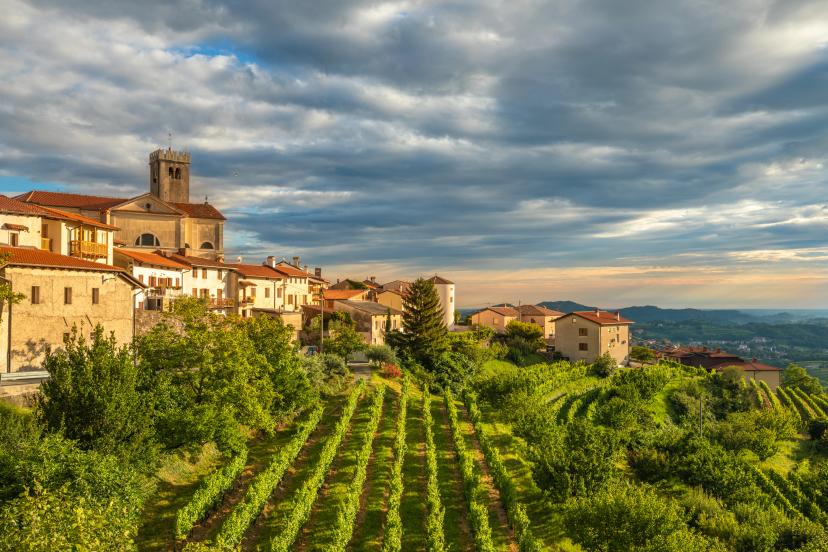
Goriška Brda
Goriška Brda is a wine-growing region on the border with Italy, often called “Slovenia’s Tuscany.” Its rolling hills are covered with vineyards, orchards, and small villages, many of which offer wine tastings and farm-to-table food. The region is known for both white and red wines, and cycling through its gentle hills is one of the best ways to explore.

Lipica Stud Farm
The Lipica Stud Farm was founded in 1580 and is the original home of the Lipizzaner horses. These horses were bred for the Habsburg court and later became famous worldwide for their performances at the Spanish Riding School in Vienna. Today, the stud farm still breeds and trains Lipizzaners, offering riding shows, guided tours, and a museum that tells the story of this historic breed.
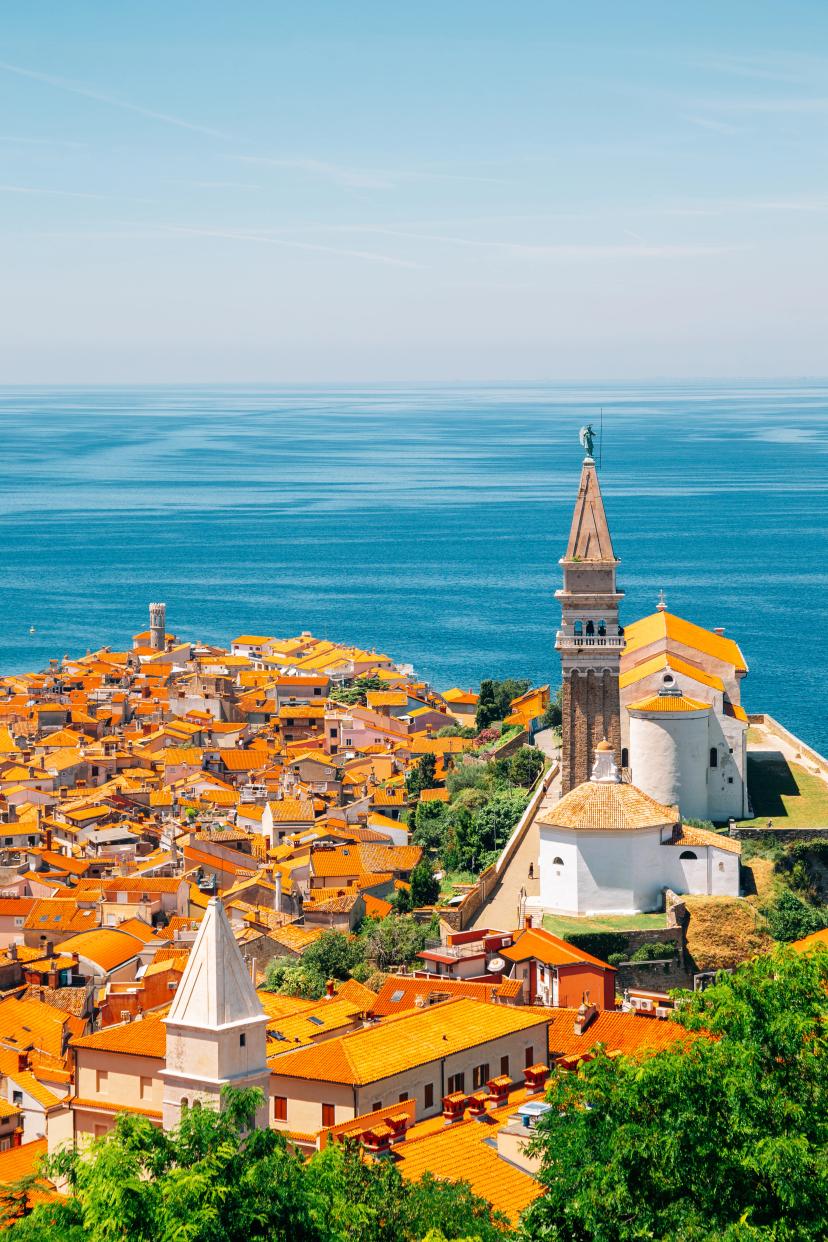
Piran
Piran is a coastal gem on the Adriatic, known for its Venetian heritage and narrow medieval streets. The main square, Tartini Square, is named after the famous violinist Giuseppe Tartini, who was born here. Climb the old city walls for panoramic views of the red-roofed town and the sea, or visit St. George’s Church, which overlooks the harbor from a bluff.

Sečovlje Saltpans
The Sečovlje Saltpans are one of the last places in the Mediterranean where salt is still harvested using centuries-old techniques. Covering about 750 hectares, the saltpans are divided into evaporation basins that double as habitats for hundreds of bird species. A salt museum explains the unique process, and visitors can even try salt-based spa treatments nearby.
Eslovenia Central
Eslovenia Central mezcla destacados culturales con fácil acceso a la naturaleza. Ljubljana, con sus cafés junto al río y vistas al castillo, es una base perfecta para explorar en bicicleta. Las ciudades medievales cercanas, los mesetas boscosas y las iglesias en la cima de las colinas añaden variedad, haciendo de esta región un lugar ideal para las vacaciones de ciclismo en Eslovenia que equilibran el descubrimiento urbano con paseos por el campo.
Explora la región en nuestro tour Vacaciones de Ciclismo en Carretera o Tour en bicicleta por las Colinas Ocultas si prefieres pastos de montaña tranquilos y pueblos.

Ljubljana
Ljubljana is Slovenia’s capital and cultural hub, with a population of just under 300,000. The Ljubljanica River runs through the center, lined with outdoor cafés and crossed by well-known bridges such as the Dragon Bridge and the Triple Bridge, both designed by architect Jože Plečnik. The city’s castle dates back to the 11th century and offers views across the entire basin. Ljubljana has been named a European Green Capital thanks to its pedestrianized center, bike-sharing system, and strong focus on sustainability.

Church of St. Thomas
The Church of St. Thomas sits on a hill near Škofja Loka and has become one of Slovenia’s most photographed landmarks. The church was first built in the 13th century, later rebuilt in Baroque style, and today still serves the local parish. A nearby roadside viewpoint frames the church with the surrounding hills and mountains, making it a favorite spot for photographers.

Golovec
Golovec Hill rises right next to Ljubljana and is covered by a dense forest crisscrossed with trails. It is one of the city’s most popular areas for mountain biking, with a maintained trail center offering downhill and enduro routes. The hill also hosts an astronomical observatory that has been operating since 1959.

Krvavec
Krvavec is Slovenia’s most accessible ski resort, located just 25 kilometers from Ljubljana and reachable by cable car. In summer, its slopes turn into a cycling and hiking area with panoramic views across the Kamnik-Savinja Alps. At 1,450–1,970 meters altitude, it also hosts outdoor festivals and alpine dairy farms producing traditional cheeses.
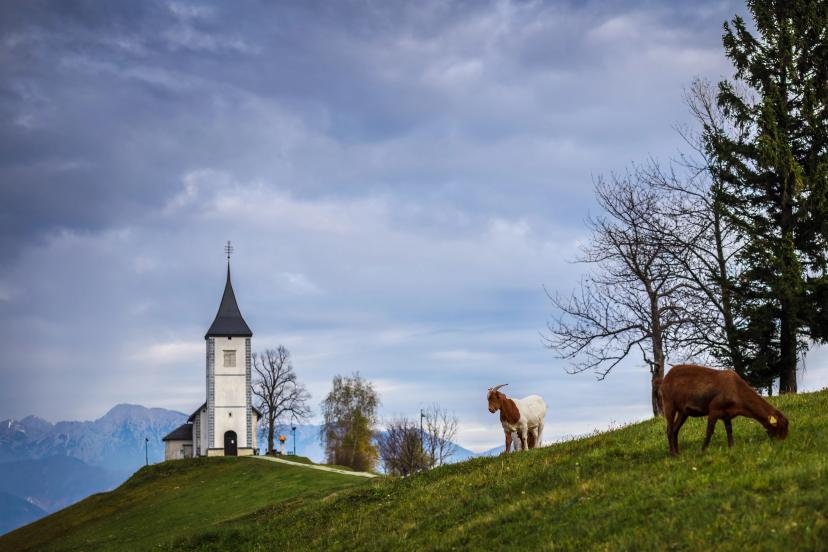
Jelovica Plateau
This vast forested karst plateau lies between Bohinj and Škofja Loka at about 1,000 m above sea level. Cloaked in spruce and fir, it was once a center for forestry and charcoal making and remains one of Slovenia’s quietest natural areas. The plateau is crowned by the hilltop St. Primož Church, whose striking white spire set against the mountains is one of the country’s most photographed landmarks.

Škofja Loka
Škofja Loka is one of Slovenia’s oldest towns, with a history dating back over a thousand years. Its medieval center is one of the best preserved in the country, dominated by a castle on a hill that today houses a museum. The town lies at the meeting of two rivers and is surrounded by a landscape full of waterfalls and hiking trails.
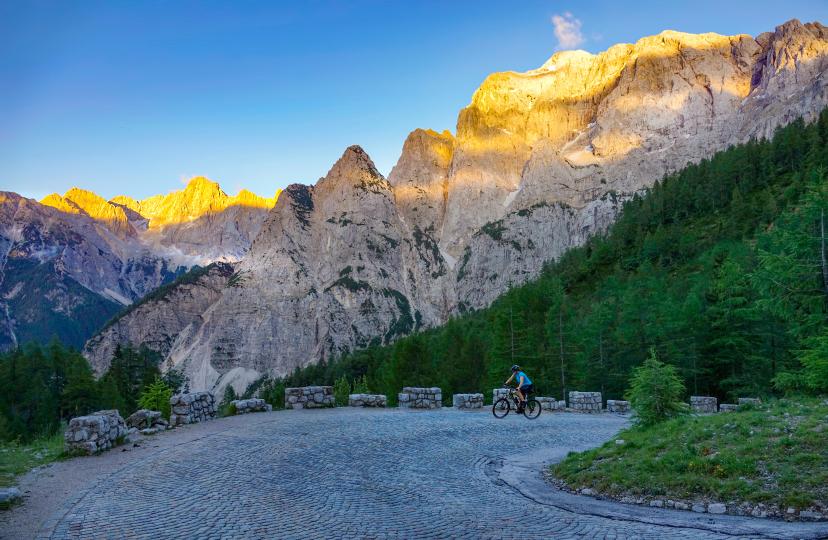
Vršič Pass
Vršič Pass is the highest road pass in Slovenia at 1,611 meters, with exactly 50 numbered hairpin turns. Built by Russian prisoners during World War I, it is still known as the “Russian Road.” The pass connects Kranjska Gora with the Soča Valley and is a popular gateway for hiking trails, mountain views, and a stop at the small Russian Chapel built in memory of the workers who died during its construction.
Los Karawanks
La cadena montañosa de los Karawanks se extiende 120 kilómetros a lo largo de la frontera con Austria, formando una división natural entre Europa Central y los Balcanes. Las cumbres se elevan por encima de los 2,000 metros, mientras que los valles alpinos, las cuevas y los pastos altos dan forma al dramático paisaje.
Una vez fue una frontera custodiada, hoy está definida por la vida tradicional de los pastores y la recreación al aire libre — y sus largos y tranquilos caminos la convierten en una de las mejores áreas para andar en bicicleta en Eslovenia.
¿Te gustaría explorarlo en bicicleta? ¡Tenemos justo el tour para ti!

Krvavec
Krvavec is Slovenia’s most accessible ski resort, located just 25 kilometers from Ljubljana and reachable by cable car. In summer, its slopes turn into a cycling and hiking area with panoramic views across the Kamnik-Savinja Alps. At 1,450–1,970 meters altitude, it also hosts outdoor festivals and alpine dairy farms producing traditional cheeses.
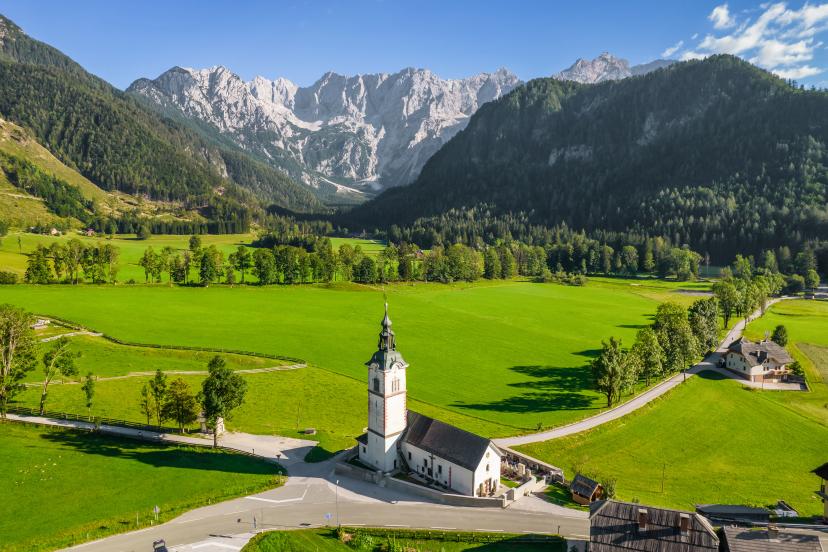
Jezersko
Jezersko is a small alpine valley north of Ljubljana, close to the Austrian border. It is named after a glacial lake that drained in the 14th century, leaving fertile meadows where farming traditions continue today. The area is known for hiking, cycling, and the healing mineral water from its springs, which has been used since the 17th century.
Eslovenia del Sur
La Eslovenia del Sur está dominada por vastos bosques, incluyendo uno de los mayores bosques primitivos de Europa. El Kočevski gozd solo cubre 500 kilómetros cuadrados y alberga osos pardos, lobos y linces. Durante la Guerra Fría, grandes áreas aquí eran zonas militares cerradas, lo que ayudó a preservar su naturaleza salvaje.
Hoy en día es una región donde las vacaciones en bicicleta en Eslovenia, especialmente para los ciclistas de MTB, adquieren un carácter más salvaje, con senderos salvajes a través de bosques profundos y un énfasis en la naturaleza virgen.
Pon a prueba tu corazón en los bosques primitivos en nuestras Vacaciones de MTB en Senderos Únicos.
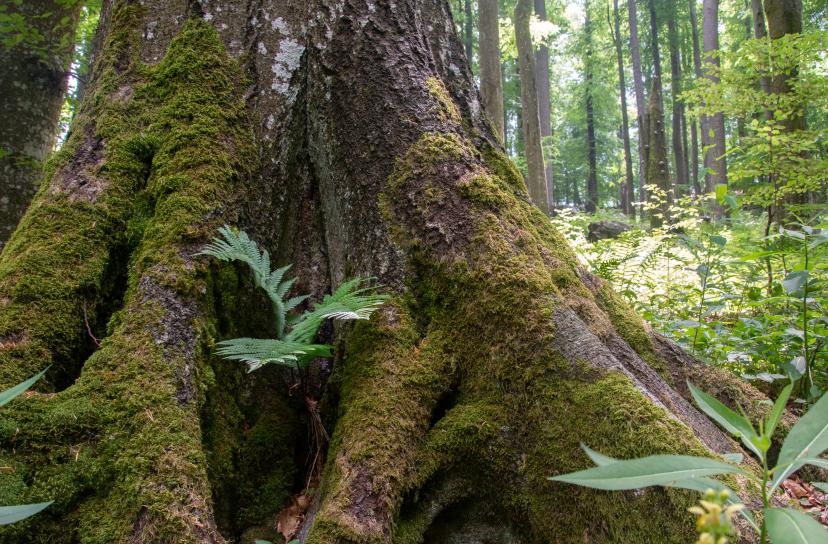
Kočevje forest info card
Kočevski gozd (forest) is the largest primeval forest in Slovenia, covering around 500 square kilometers. The area is home to rare wildlife, including brown bears, wolves, and lynxes, making it one of the most important biodiversity reserves in Europe. Visitors can explore marked trails, guided bear-watching tours, and learn about the area’s history as a former restricted military zone during the Cold War.
Atravesando la Frontera: Italia y Croacia
Muchas vacaciones de ciclismo en Eslovenia se extienden sin problemas hacia la cercana Italia y Croacia, añadiendo aún más variedad al recorrido. En Italia, los ciclistas pueden enfrentarse a los Dolomitas, un sitio Patrimonio de la Humanidad de la UNESCO cuyos legendarios puertos han dado forma al Giro de Italia. En Croacia, la península de Istria ofrece herencia romana, pueblos en lo alto de colinas y bosques ricos en trufas.
Para aquellos que quieren experimentar todo, organizamos viajes multiculturales que muestran lo mejor de la región. Las opciones incluyen el Ciclismo Definitivo a Través de Eslovenia y Croacia, el Desafío de Carretera de los Dolomitas Legendarios y Eslovenia, y el tour de Ciclismo de Carretera Eslovenia, Italia y Croacia—cada uno combinando paisajes inolvidables, ascensos icónicos y las ricas culturas de tres países vecinos.
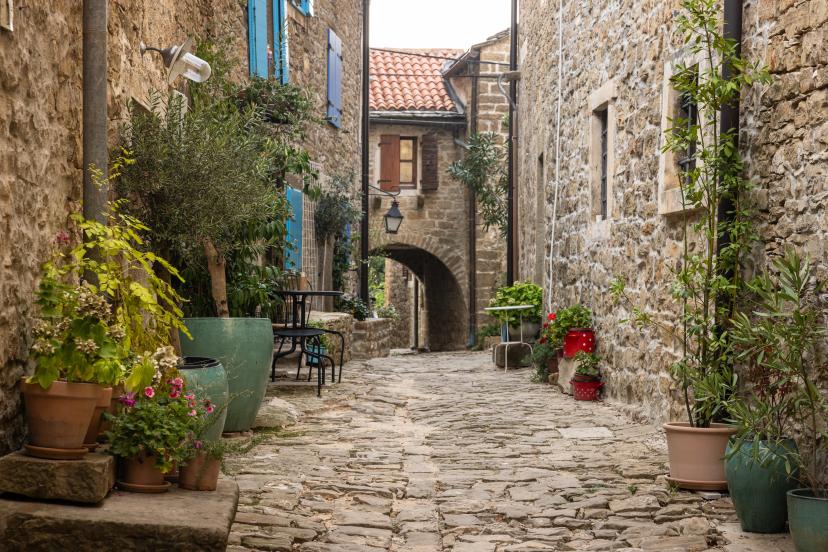
Grožnjan
Perched on a hilltop in Croatia’s Istrian peninsula, Grožnjan is renowned as the “town of artists.” Its medieval stone lanes are packed with more than twenty galleries and studios, and music festivals fill the narrow streets each summer. With panoramic views over vineyards and olive groves, Grožnjan blends history, art, and a relaxed Mediterranean charm that makes it a favorite stop for culture lovers and cyclists crossing the border from Slovenia.

Motovun
Just a short ride away, Motovun rises dramatically above the Mirna River valley and is famed for its intact medieval walls and sweeping views across central Istria. The town is at the heart of Croatia’s truffle region, offering everything from simple truffle tastings to fine dining. Its cobbled streets, Venetian architecture, and surrounding forests make Motovun both a culinary hotspot and one of the most atmospheric hill towns in the region.
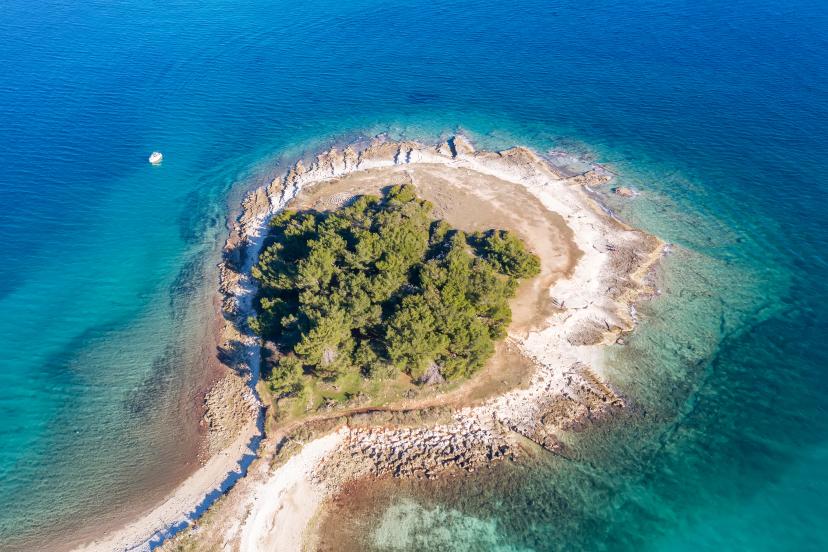
Premantura
Premantura is the southernmost tip of the Istrian peninsula, known for the protected landscape of Cape Kamenjak. The cape is dotted with coves, cliffs, and beaches, and its coastline stretches for about 30 kilometers. Cyclists and hikers can explore its trails, while swimmers and divers are drawn to its clear waters and unique rock formations.
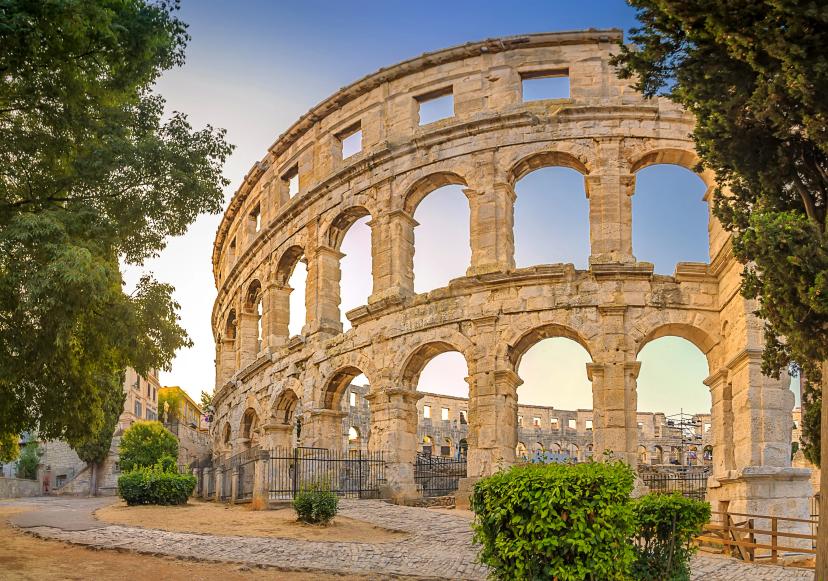
Pula
Pula, at the southern tip of Croatia’s Istrian peninsula, is known for its Roman heritage. The highlight is the well-preserved Roman amphitheater, built in the 1st century and still used for concerts and events today. The city also features Roman temples, medieval fortresses, and a busy port that reflects its long history as a crossroads of Mediterranean cultures.

Wurzenpass
Wurzenpass, at 1,073 meters, is a mountain pass connecting Slovenia and Austria. The road is steep, with gradients reaching 18%, and was once an important military route. At the top sits the Bunkermuseum, an open-air museum of Cold War bunkers built in the 1960s to defend against a possible invasion.
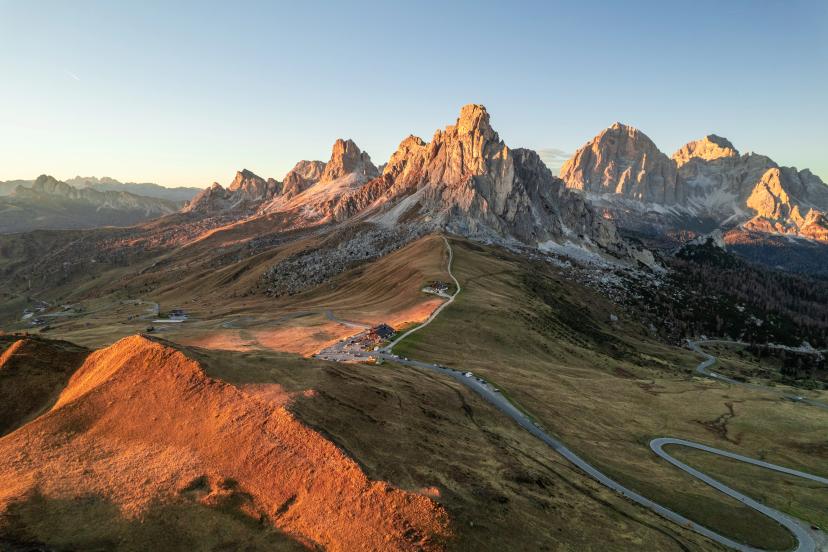
Passo Giau
Passo Giau is one of the most scenic high mountain passes in the Dolomites, standing at 2,236 meters. The road climbs with 29 hairpin bends and has often featured in the Giro d’Italia, making it a legendary route for cyclists. From the top, the views stretch to peaks like Tofane and Marmolada, making it a favorite stop for photographers and riders alike.

Lago del Predil
Planifica tu escapada en bicicleta por Eslovenia
¿Te sientes inspirado por los paisajes de Eslovenia? Explora nuestra selección completa de tours en bicicleta en Eslovenia o contáctanos para planificar tu propio recorrido.
.jpg&w=3840&q=75)

Expertos locales
Nuestros guías de ciclismo profesionales conocen el terreno local y están capacitados para hacer de esta oportunidad única en la vida algo seguro y agradable.

Sin complicaciones
Nos encargamos de los itinerarios, alojamientos y cualquier otra cosa que prefieras no manejar, para que puedas disfrutar de unas vacaciones sin preocupaciones.

Totalmente personalizable
La flexibilidad es nuestro segundo nombre: ya sea que desees más o menos, o simplemente algo más allá de lo ordinario, lo haremos realidad.

Reserva con confianza
Somos una empresa financieramente protegida, totalmente vinculada y asegurada, que mantiene su dinero a salvo y le permite viajar con confianza.

Soporte inigualable
Nuestro servicio de atención al cliente 24/7 es donde mostramos nuestra pasión, ofreciéndole una mejor experiencia al hacer de su bienestar nuestra prioridad número uno.
